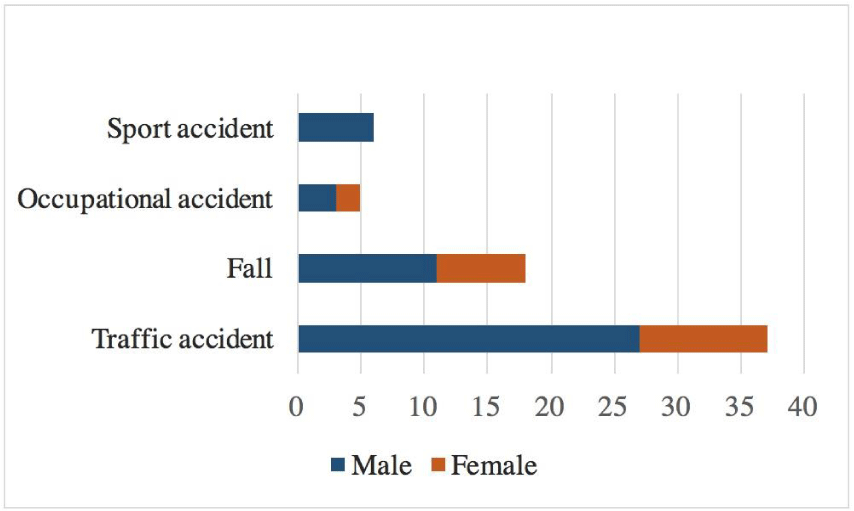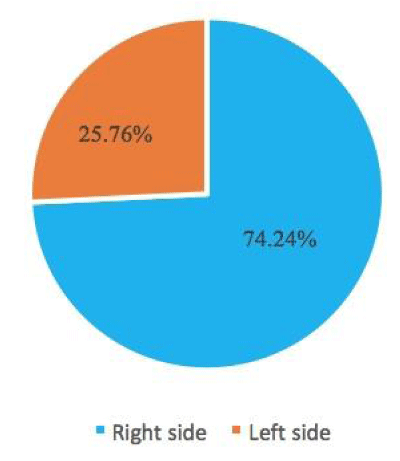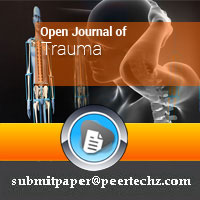Open Journal of Trauma
The Surgical Outcomes of Diaphyseal Fractures of Radius and Ulna treated by Plate and Screws Fixation in Vietnam
Dung Tran Trung1,2*, Khanh Trinh Le2, Tuyen Nguyen Trung1, Binh Nguyen Duc1, Lam Tran Quoc2, Manh Nguyen Huu2, Phuong Nguyen Huy1,2, Nam Vu Tu1,2 and Hieu Pham Trung1,2
2Hanoi Medical University, Vietnam
Cite this as
Trung DT, Le KT, Trung TN, Duc BN, Quoc LT, et al. (2017) The Surgical Outcomes of Diaphyseal Fractures of Radius and Ulna treated by Plate and Screws Fixation in Vietnam. Open J Trauma 1(3): 066-068. DOI: 10.17352/ojt.000013Objectives: 1) Study the clinical and radiographic characteristics of both bones forearm fractures in adults. 2) Evaluate the surgical outcomes of plate and screws fixation for these fractures.
Material and methods: This retrospective study included 66 cases of both bones forearm fractures who were treated by open reduction and internal fixation (ORIF) with plate and screws at Viet Duc Hospital and Hanoi Medical University Hospital between January 2010 and June 2013.
Results: The average age of the patients was 34.73 ± 13.54; the ratio of men to women was 2.5/1; Traffic accident was the major mechanism of injury; fractures of middle third of radius and ulna were the most common, accounting for 48.49% of cases. Fractures in left-side were more than right. The surgical outcomes were excellent in 75.8% of cases, satisfactory in 18.2% and unsatisfactory in 6%. There were no failures.
Conclusion: Plate and screws fixation of both bones forearm fractures had good results.
Introduction
Both bones forearm shaft fractures are common orthopedic injuries [1]. These fractures do not include the Galeazzi and Monteggia fractures-dislocations.
The function of the forearm is very important, especially pronation and supination. These movements are directly involved to the precise movements of the hand. To ensure this function, in addition to the soft tissues such as muscles and nerves, the anatomical relationship of the radius and ulna plays an important role. In both bones forearm fractures, the displacement is often complicated due to the forces of the attached muscles [1,2].
Previously, conservative treatment using closed reduction and casting was the most common method for these fractures. However, as a result of difficulty in restoring the natural anatomy of radius and ulna, restoration of function remained limited [3]. Therefore, the current trend of early surgical intervention is more and more popular.
The aims of this paper:
1) Study the clinical and radiographic characteristics of both bones forearm fractures in adults.
2) Evaluate the surgical outcomes of plate and screws fixation for these fractures.
Material and Methods
This retrospective study included 66 cases of both bones forearm shaft fractures who were treated by open reduction and internal fixation (ORIF) with plate and screws at Viet Duc Hospital and Hanoi Medical University Hospital between January 2010 and June 2013.
The inclusion criteria were age of 15 years or older, non-pathological fracture, having a full medical record. The exclusion criteria were open fractures, pathological fractures, both bones forearm fractures were treated by another technique.
The Anderson forearm fractures outcome classification (Table 1) was used to determine the final outcome [4].
Statistical analysis was performed using SPSS Version 16.6.
Ethical issues in research: All patients have consented to use their medical information for scientific research and we ensure that their personal information will be kept confidential.
Results
There were 47 (71.21%) men and 19 (28.79%) women. The average age of the patients was 34.73 ± 13.54, most of the patients were of working age (Table 2). The mechanism of injury was a traffic accident in 37 cases (%), a fall in 18 (%), occupational accident in 5 (%), and sport accident in 6 cases (%) (Figure 1).
There were 49 (72.24%) left and 17 (25.76%) right side fractures. Fractures of proximal, middle and distal third of forearm were 4 (6.06%), 32 (48.49%) and 17 (25.76%), respectively. Thirteen fractures (19.69%) were not at the same level (Table 3).
Time between the injury and the surgery is shown in (Table 4). Of the 66 patients in this study, 25 (37.88%) were operated within the first day, 21 (31.81%) were operated between day 2 and 7, 13 (19.70%) between day 8 and 30 and 7 (10.61%) between day 31 and 35 after the injury.
These were six (9.09%) cases of superficial incisional surgical site infection, the others (90.91%) had good incision healings. Postoperative x-rays showed good results in 59 (89.39%) and minimal displacement (not perfect reduction with less than the cortical thickness of displacement) in 7 (10.61%) cases. There were no cases of significant displacement (Table 5).
The surgical outcomes according to Anderson classification are shown in (Table 6). It was found that 50 (75.76%) of patients had excellent results, 12 (18.18%) had satisfactory results and 4 (6.06%) had unsatisfactory results. There were no failures.
Discussion
The mean age of the patients in our study was 34.73 ± 13.54. Patients in the working age group (15-50) accounted for the highest rate (51.25%). This is consistent with the finding of Chapman and Hertel. The average age in their studies were 33 and 38 years, respectively [8,9]. The ratio of men to women was 2.5/1, it is equivalent to that in Chapman’s study (men to women ratio of 2.7/1) [8]. Traffic accident was the most common injury mechanism (Figure 1). Similar to Garland D.E [7], injury in left side was more than right side. The reason is that most people are right-handed, so the left hand is less responsive when in an accident, therefore is at higher risk of fracture. In this study, the incidence of the left hand injuries was nearly three times more than the right hand (Figure 2).
Fractures of the middle and distal third of the forearm were the most common (48.49% and 25.76%, respectively). Thirteen fractures (19.69%) were not at the same level (Table 3). Chapman also reported in his study that the typical pattern was middle third fractures [8].
All patients were operated on between day 1 and 35 after the injury. In 46 patients (69.69%) who were operated within the first week, 25 patients (37.88%) were operated on the first day (Table 4), all of these patients were operated at Hanoi Medical University Hospital. Twenty-one patients (31.81%) were operated on between day 2 and 7, and 13 patients (19.69%) were operated on between day 7 and 30 (Table 4). Interventions after 7 days were usually due to delayed hospitalization, after failure of conservative treatment or other methods. Chapman noted that the first week after the injury is the appropriate time to operate in the fractures of forearm, with nearly 90% of patients were received surgical intervention within this time in his study [8].
There were 60 cases (90.91%) of good incision healing, 6 cases (9.09%) of superficial incisional surgical site infection but they were completely cured with antibiotic treatment (Table 5). The union rate was 100%. Among them, 60 cases had good anatomical alignment and 6 cases had a minimal displacement (less than the thickness of a cortex). There were no cases of nonunion (Table 5). Thus, our results were similar to those of other authors such as Anderson LD [4], Haas N [5], Hadden WA [6], Garland D.E [7], Chapman M.W [8] and Hertel R [9].
The results in Table 6 show that 75.8% achieved excellent results, 18.2% satisfactory and 6% unsatisfactory. The unsatisfactory cases were mainly due to a complicated fracture with a severe soft tissues injury. Our results were consistent with the finding of some other authors (Table 7).
Conclusion
Both bones forearm fractures are common in men of working age. The major mechanism of these fractures is traffic accident. Fractures of the middle third are most common and fractures in left-side are more than right.
In this study, the surgical outcomes were excellent in 75.8% of cases, satisfactory in 18.2% and unsatisfactory in 6%. There were no failures.
- Philipp NS, Rodrigo FP (2015) Diaphyseal Fractures of The Radius and Ulna. In: Charles MC, James DH, Margaret MM, editors. Rockwood and Green’s Fractures in Adults, 8th ed. vol 1. Wolters Kluwer. 33: 1121–1177.
- Edward AP (2008) Fractures of shoulder, arm, and forearm. In: Canale ST, James HB, editors. Campbell's Operative Orthopaedics. 12th ed. Elsevier Mosby 57: 2829–2903.
- Charnley J (1999) The Closed Treatment of Common Fractures, 4th ed. Cambridge University Press. VIII: 116–127. Link: https://goo.gl/H1eX7w
- Anderson LD, Sisk D, Tooms RE, Park WI 3rd (1975) Compression plate fixation in acute diaphyseal fractures of radius and ulna. J Bone Joint Surg Am 57: 287–297. Link: https://goo.gl/MC7cHj
- Haas N, Hauke C, Schütz M, Kääb M, Perren SM (2001) Treatment of diaphyseal fractures of the forearm using the Point Contact Fixator (PC-Fix): results of 387 fractures of a prospective multicentric study (PC-Fix II). Injury 32: B51–B62. Link: https://goo.gl/XsZhoz
- Hadden WA, Reschauer R, Seggl W (1983) Results of AO plate fixation of forearm shaft fractures in adults. Injury 15(1): 44–52. Link: https://goo.gl/Z9bqra
- Garland DE, Downing V (1983) Forearm fractures in the head injured adult. Clin Orthop Relat Res 176: 190–196. Link: https://goo.gl/jmvRuA
- Chapman MW, Gordon JE, Zissimos AG (1989) Compression plate fixation of acute fractures of diaphysis of the radius and ulna. J Bone Joint Surg Am 71: 159–169. Link: https://goo.gl/5qiykD
- Hertel R, Pisan M, Lambert S, Ballmer FT (1996) Plate osteosynthesis of diaphyseal fractures of the radius and ulna. Injury 27: 545–548. Link: https://goo.gl/Pe6Y4c
- Leung F, Chow SP (2006) Locking compression plate in the treatment of forearm fractures: a prospective study. J Orthop Surg (Hong Kong) 14: 291–294. Link: https://goo.gl/s4V9Ey
- Droll KP, Perna P, Potter J, Harniman E, Schemitsch EH, et al. (2007) Outcomes following plate fixation of fractures of both bones of the forearm in adults. J Bone Joint Surg Am 89: 2619-2624. Link: https://goo.gl/oWu2mZ
- Sang Bum Kim, Heo YM, Yi YW, Lee JB, Lim BG (2015) Shaft Fractures of Both Forearm Bones: The Outcomes of Surgical Treatment with Plating Only and Combined Plating and Intramedullary Nailing. Clin Orthop Surg 7: 282–290. Link: https://goo.gl/QnPfxf
- Lindvall EM, Sagi HC (2006) Selective screw placement in forearm compression plating: results of 75 consecutive fractures stabilized with 4 cortices of screw fixation on either side of the fracture. J Orthop Trauma 20: 157–162. Link: https://goo.gl/1NzSfr
- Crow BD, Mundis G, Anglen JO (2007) Clinical results of minimal screw plate fixation of forearm fractures. Am J Orthop 36: 477–480. Link: https://goo.gl/EPYQzn
Article Alerts
Subscribe to our articles alerts and stay tuned.
 This work is licensed under a Creative Commons Attribution 4.0 International License.
This work is licensed under a Creative Commons Attribution 4.0 International License.



 Save to Mendeley
Save to Mendeley
